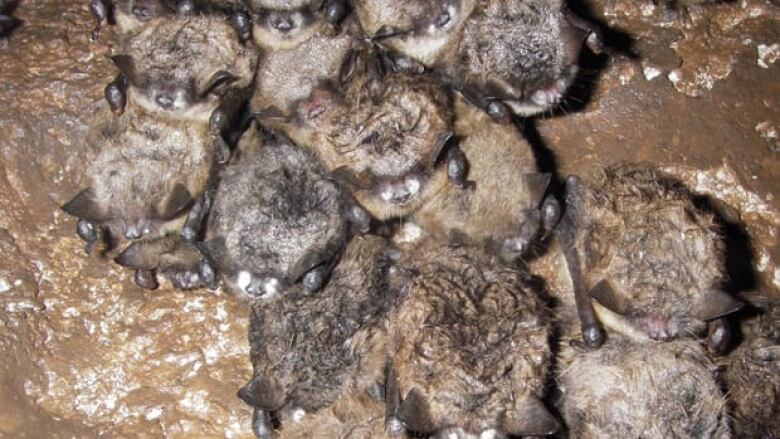Deadly bat fungus hits N.B.
Could wipe out little brown bat population

Afungus that is decimating bat populations in northeastern North America has spread to New Brunswick.
The deadly disease, called white-nose syndrome, was identified in New York in 2006 and was recently foundby a team of researchers in hibernating bats in a cave inAlbert County, N.B.
The team visted eight caves in the province last year and didn't find any evidence of white-nose syndrome, saidmember Don McAlpine, who is the head ofzoology at the New Brunswick Museum.But this year was different, he said.
The first five caves were clear, but McAlpine said he immediately knew there was a problemwhen they arrived at the sixth cave, which is home to 6,000 hibernating bats.
As the researchers approached, they saw dead bats outside on the ground and others leaving the cave, which was abnormal.
"Inside it was dead bats everywhere," McAlpine said."The floor was littered with batsmore than 1,200 of them were dead on the floor and a large number on the walls were also visibly infected with white-nose and we don't expect them to last the winter."
Wildlife tragedy

White-nose syndrome affects the behaviour of bats, causing them to wake up too frequently during their hibernation. That burnsbody fat, which leads the bats to believe winter is over.
"They decide spring has arrived and go to the mouth of the cave and don't survive the winter," said McAlpine.
He calls the arrival of white-nose syndrome a "wildlife tragedy" and says the little brown bat could be erased by the fungus.
"There's been modeling done that suggests over the next perhaps two decades the little brown bat, which is the principle bat that's been affectedcould go from being perhaps one of the most common small mammals in the eastern part of the continent, to being endangered, to perhaps being totally extinct," said McAlpine.
Bats can live between 30 and 35 years and have a relatively low birth rate, with only one young born every year, he explained. Soit could take many years for the population to recover.
White-nose syndrome has been discovered in bat populations in New Brunswick, Ontario, Quebec, and 16 states.The fungus is also present in Europe, but McAlpine said so far the bats there seem to be resistant to it.
McAlpine said efforts are underway to slow the spread of the fungus in New Brunswick by restricting access to caves so spores won't be transported by recreational cavers.












_(720p).jpg)


 OFFICIAL HD MUSIC VIDEO.jpg)
.jpg)



























































































